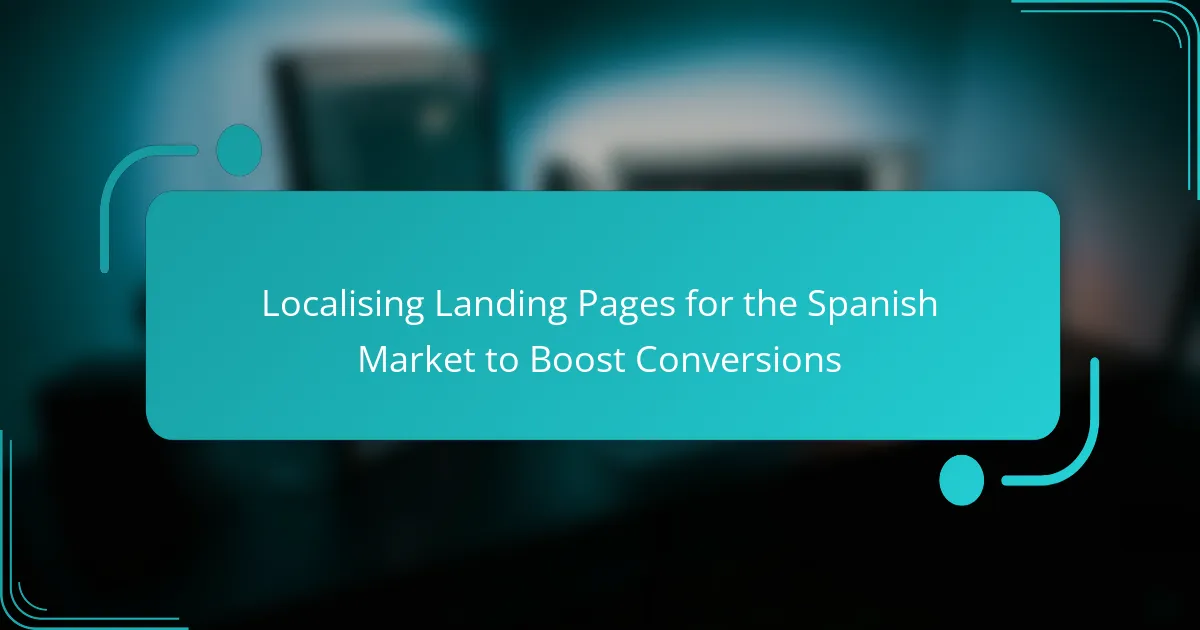Localising landing pages for the Spanish market is essential for maximising engagement and conversions. By focusing on language nuances, cultural relevance, and local SEO strategies, businesses can create content that resonates with Spanish-speaking audiences, leading to improved user experiences and higher conversion rates.
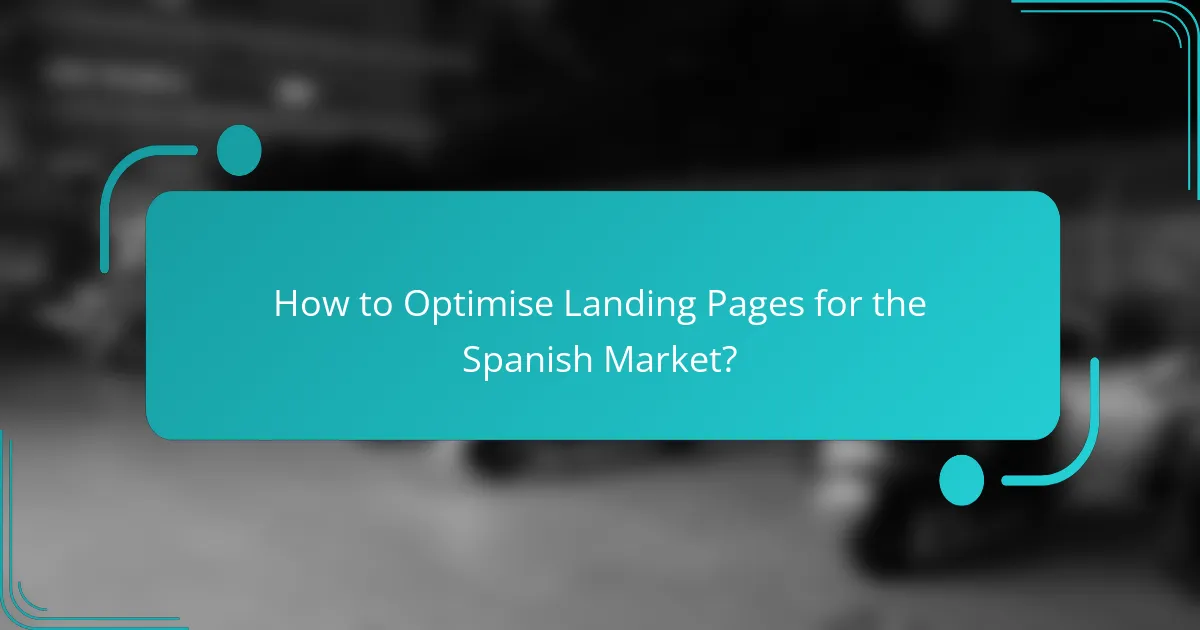
How to Optimise Landing Pages for the Spanish Market?
To effectively optimise landing pages for the Spanish market, focus on language, cultural relevance, and local SEO. Tailoring content to resonate with Spanish-speaking audiences can significantly enhance user engagement and conversion rates.
Use Spanish Language Content
Creating content in Spanish is essential for connecting with the target audience. This includes not only translating existing material but also ensuring that the language is culturally appropriate and idiomatic. Consider hiring native speakers for content creation to maintain authenticity.
Utilise local dialects and variations, as Spanish can differ significantly across regions. For example, the Spanish spoken in Spain may differ from that in Latin America, so tailor your content accordingly to meet regional preferences.
Incorporate Local Cultural References
Integrating local cultural references can make your landing pages more relatable and engaging. Use examples, idioms, or imagery that resonate with Spanish culture, such as popular festivals, cuisine, or sports. This helps build a connection with the audience.
Be mindful of cultural sensitivities and avoid stereotypes. Research local customs and traditions to ensure your references are respectful and relevant, enhancing the overall user experience.
Utilise Local SEO Strategies
Implementing local SEO strategies is crucial for visibility in the Spanish market. Focus on keywords that are commonly used by Spanish speakers and optimise your landing pages accordingly. Tools like Google Keyword Planner can help identify effective terms.
Incorporate local backlinks and engage with local influencers to boost your site’s authority. Registering your business with local directories can also improve your search rankings and increase traffic to your landing pages.
Implement Mobile Optimisation
Mobile optimisation is vital, as a significant portion of users access websites via smartphones. Ensure that your landing pages are responsive and load quickly on mobile devices to enhance user experience. Aim for load times under three seconds.
Consider simplifying navigation and reducing content clutter on mobile versions. Use larger buttons and clear calls to action to facilitate easy interaction, which can lead to higher conversion rates among mobile users.
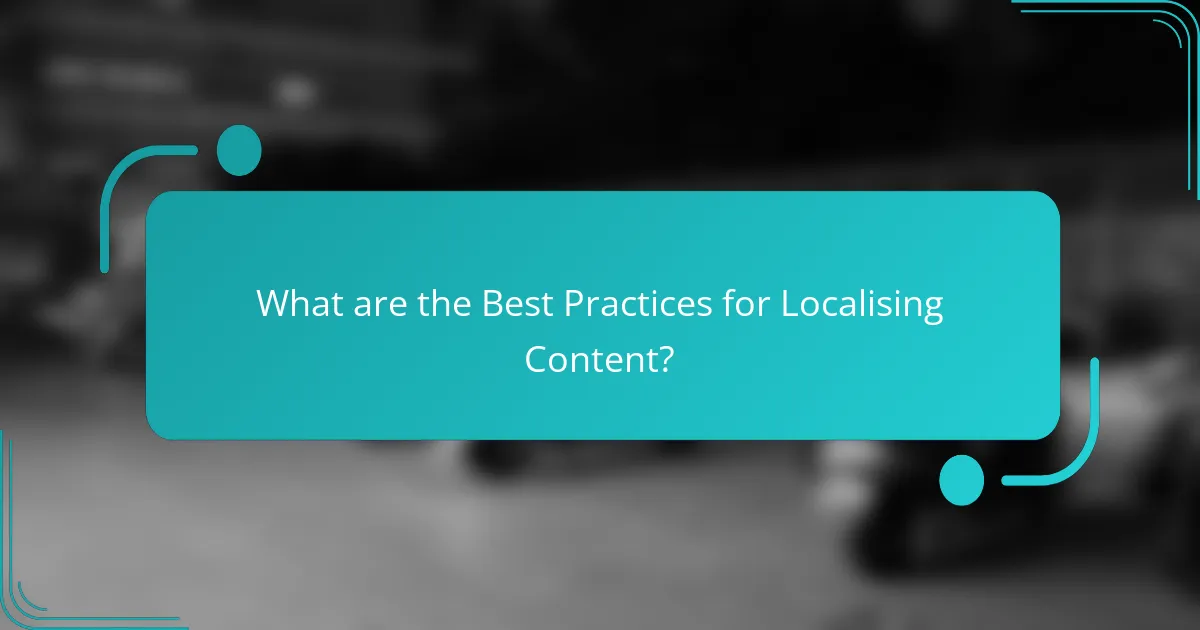
What are the Best Practices for Localising Content?
To effectively localise content for the Spanish market, focus on cultural relevance, language nuances, and consumer preferences. Implementing best practices ensures that your messaging resonates with the local audience, ultimately boosting conversions.
Conduct Market Research
Conducting thorough market research is essential for understanding the Spanish audience. Analyse demographics, preferences, and purchasing behaviours to tailor your content accordingly.
Utilise surveys, focus groups, and online analytics to gather insights. This data will help you identify which aspects of your product or service appeal most to Spanish consumers.
Utilise Localised Keywords
Incorporating localised keywords is crucial for improving search visibility and relevance. Research popular search terms used by Spanish speakers and integrate them into your content naturally.
Use tools like Google Keyword Planner or SEMrush to find relevant keywords. Aim for a mix of high-volume and long-tail keywords to capture a broader audience while addressing specific needs.
Engage Local Influencers
Engaging local influencers can significantly enhance your brand’s credibility and reach in the Spanish market. Collaborate with influencers who resonate with your target audience to promote your content authentically.
Choose influencers based on their engagement rates and relevance to your industry. A well-structured partnership can lead to increased brand awareness and higher conversion rates.
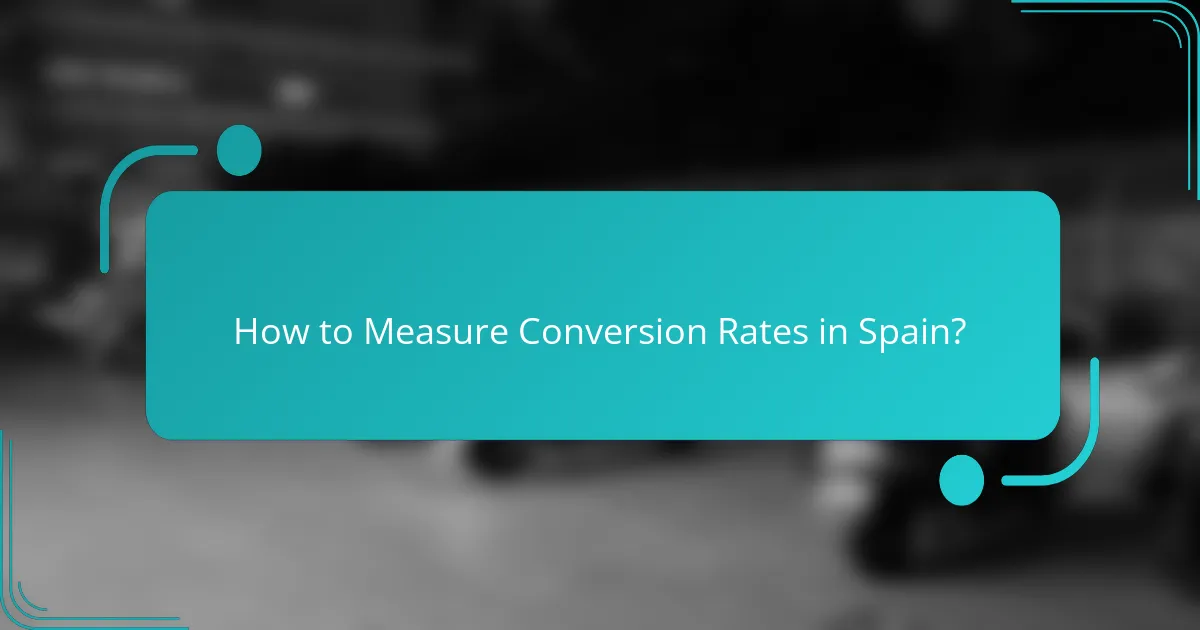
How to Measure Conversion Rates in Spain?
Measuring conversion rates in Spain involves tracking user actions on your landing pages to determine how effectively they drive desired outcomes, such as purchases or sign-ups. Key metrics include the percentage of visitors who complete these actions and the average time spent on the page.
Use Google Analytics for Tracking
Google Analytics is a powerful tool for measuring conversion rates in Spain. Set up goals that align with your business objectives, such as form submissions or product purchases. This allows you to track how many users complete these actions relative to the total visitors.
To get started, create a Google Analytics account and add the tracking code to your landing pages. Monitor key metrics like the conversion rate, bounce rate, and average session duration to gain insights into user engagement and behaviour.
Analyse User Behaviour with Heatmaps
Heatmaps provide visual representations of user interactions on your landing pages, showing where visitors click, scroll, and spend the most time. This analysis helps identify which elements attract attention and which may need improvement to boost conversion rates.
Tools like Hotjar or Crazy Egg can be integrated with your website to generate heatmaps. Look for patterns in user behaviour, such as areas with high engagement or sections that are ignored, and adjust your design or content accordingly to enhance user experience and increase conversions.
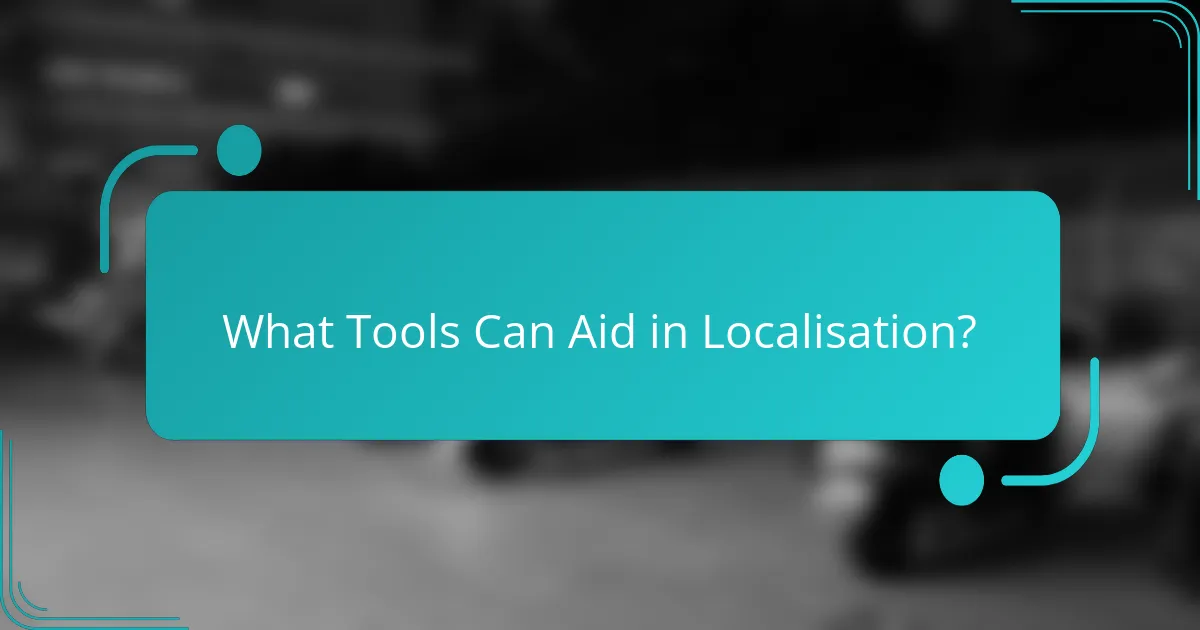
What Tools Can Aid in Localisation?
Several tools can significantly enhance the localisation of landing pages for the Spanish market, focusing on keyword research, competitor analysis, and landing page testing. Utilising these tools effectively can lead to improved conversion rates and a better understanding of local preferences.
SEMrush for Keyword Research
SEMrush is a powerful tool for identifying relevant keywords that resonate with the Spanish audience. By analysing search volumes and trends, you can discover which terms potential customers are using, allowing you to tailor your content accordingly.
When using SEMrush, focus on long-tail keywords that reflect local language nuances. For example, instead of just “zapatos,” consider “zapatos de cuero para hombre” to capture more specific searches. Regularly update your keyword list to stay aligned with changing consumer behaviour.
Ahrefs for Competitor Analysis
Ahrefs enables you to analyse your competitors’ strategies in the Spanish market. By examining their top-performing pages and backlink profiles, you can identify successful tactics and gaps in your own approach.
Look for keywords that your competitors rank for but you do not. This can provide insights into potential content opportunities. Additionally, pay attention to the type of content that engages the local audience, whether it’s blog posts, videos, or infographics.
Unbounce for Landing Page Testing
Unbounce is an excellent platform for creating and testing landing pages tailored to the Spanish market. It allows you to design pages without needing extensive coding skills, making it easier to implement localised content quickly.
Utilise A/B testing features to compare different headlines, images, and calls to action. For instance, test variations of a call to action like “Compra ahora” versus “Adquiere el tuyo hoy” to see which resonates better with your audience. Regular testing can help optimise conversion rates over time.
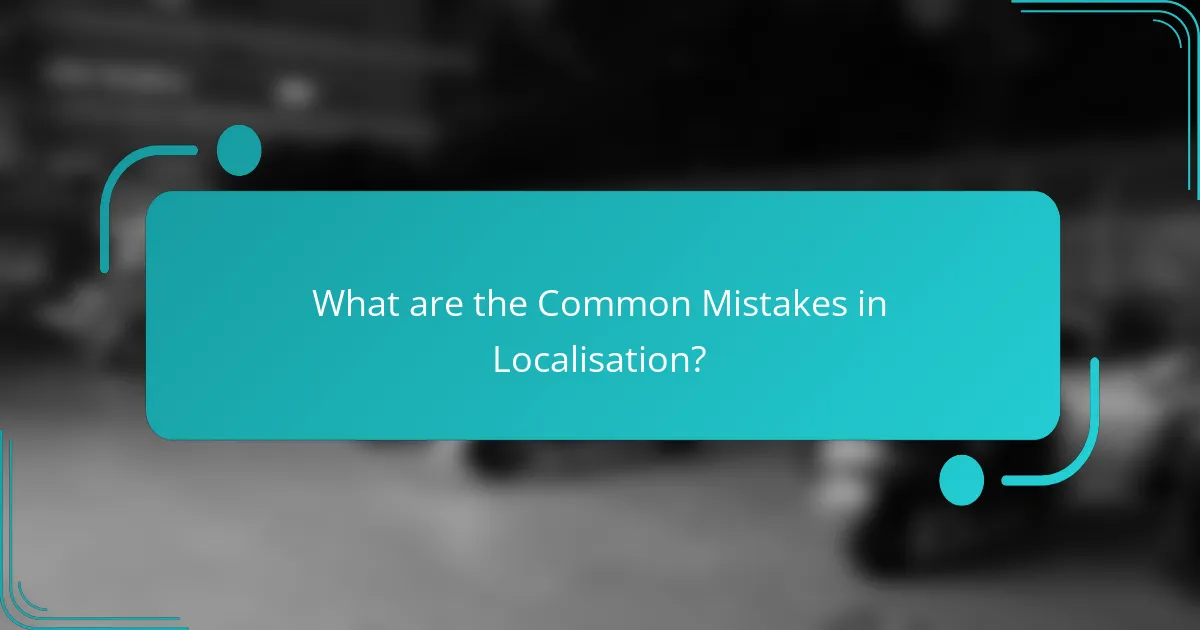
What are the Common Mistakes in Localisation?
Common mistakes in localisation can significantly hinder the effectiveness of landing pages aimed at the Spanish market. These errors often stem from a lack of understanding of cultural differences, reliance on automated tools, and neglecting local preferences.
Ignoring Cultural Nuances
Ignoring cultural nuances can lead to misinterpretations and alienation of the target audience. For example, colours, symbols, and phrases that are acceptable in one culture may be offensive or confusing in another. Understanding local traditions, holidays, and social norms is crucial for resonating with Spanish consumers.
To avoid this mistake, conduct thorough research on cultural references and preferences. Engaging local experts or native speakers can provide valuable insights. Tailoring content to reflect local customs can enhance relatability and trust, ultimately boosting conversion rates.
Using Automated Translation Tools
Using automated translation tools can result in awkward phrasing and loss of context, which may frustrate potential customers. While these tools can be helpful for initial drafts, they often fail to capture the subtleties of language, especially in marketing contexts. A phrase that works well in English may not translate effectively into Spanish.
For effective localisation, consider hiring professional translators who are familiar with marketing language and cultural context. This ensures that your message is not only accurately translated but also resonates with the target audience. Investing in quality localisation can lead to higher engagement and conversion rates.
